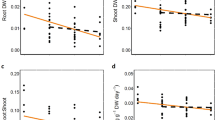Abstract
Aquatic and semi-aquatic plants comprise few species worldwide, yet the introduction of non-indigenous plants represents one of the most severe examples of biological invasions.
My goal is to compare the distribution and the biology of aquatic and semi-aquatic plants in their introduced ranges and in their native ranges. The primary objective of this study is to test the hypothesis that invasive species have evolved traits likely to increase their success in the new range. I made two reciprocal comparisons, i.e. I compared European species in France and in North America, and North American species in France and in North America. Twenty-seven species were classified according to their invasiveness in their introduced area. I␣found six invasive macrophyte species in France native to North America and 17 invasive species in North America native to Europe. Four species are invasive in both areas. There is no general tendency for macrophytes to be more vigorous in their introduced ranges. Most non-indigenous aquatic and semi-aquatic species are potentially invasive or widespread and well-established in their introduced country, while few species seem to be restricted in their distribution.
Similar content being viewed by others
References
Aboucaya A (1999) Premier bilan d’une enquête nationale destinée à identifier les xénophytes invasifs sur le territoire métropolitain français (Corse comprise). Bulletin de la société botanique du centre-ouest, NS 19: 463–482
Barrat-Segretain MH (2001) Invasive species in the Rhône river floodplain (France): replacement of Elodea canadensis Michaux by Elodea nuttallii St John in two former river channels. Archiv für Hydrobiologie 152: 237–251
Barrett CH, Echert CG and Husband BC (1993) Evolutionary processes in aquatic plant populations. Aquatic Botany 44: 105–145
Blossey B and Nötzold R (1995) Evolution of increased competitive ability in invasive nonindigenous plants: a hypothesis. Journal of Ecology 83: 887–889
Bornette G, Henry CP, Barrat M-H and Amoros C (1994) Theorical habitat templets, species traits, and species richness: aquatic macrophytes in the Upper Rhône River and its floodplain. Freshwater Biology 31: 487–505
Carpenter SR and Lodge DM (1986) Effects of submersed macrophytes on ecosystem processes. Aquatic Botany 26: 341–370
Chevenet F, Doledec S and Chessel D (1994). A fuzzy coding approach for the analysis of long-term ecological data. Freshwater Biology 31: 295–309
Crawley MJ (1987) What makes a community invasible?. In: Gray AJ, Crawley MJ and Edwards KR (eds) Colonization, Succession and Stability. Blackwell Scientific Publications, Oxford, pp 429–453
Flora of North America (1993) Editorial Committee eds. 1993. New York and Oxford
Garbey C, Thiébaut G and Muller S (2004) Morphological plasticity of a spreading aquatic macrophyte, Ranunculus peltatus, in the NE of France. Plant Ecology 173: 125–137
Grime JP (2001) Plants strategies, Vegetation processes and Ecosystem properties. Second edition. Wiley, Chischester
Kareiva P (1996) Developing a predictive ecology for non-indigenous species and ecological invasions. Ecology 77: 1651–1652
Lodge DM (1993) Biological invasions: lessons for ecology. Trends in Ecology and Evolution 8: 133–137
Lonsdale WM, (1999) Global patterns of plant invasions and the concept of invasibility. Ecology 80: 1522–1536
Lui K, Thompson FL and Eckert CG (2005) Causes and consequences of extreme variation in reproductive strategy and vegetative growth among invasive populations of a clonal aquatic plant, Butomus umbellatus L. (Butomaceae). Biological Invasions 7(3): 427–444
Muller et coll. (2004). Plantes invasives en France. Etat des connaissances et propositions d’actions. Paris, Museum national d’Histoire naturelle, 2004. (Patrimoines naturels, 62)
Müller-Schärer H, Schaffner U and Steinger T (2004) Evolution in invasive plants: implications for biological control. Trends in Ecology and Evolution 19(8): 417–422
Pysek P, Richardson DM, Rejmanek M, Webster GL, Williamson W and Kirschner J, (2004) Alien plants in checklists and floras: toward better communication between taxonomists and ecologists. Taxon 53(1): 131–143
Sculthorpe CD (1967) The Biology of Aquatic Vascular Plants. Edward Arnold Ltd, London
Stuckey RL (1993) Phytogeographical outline of aquatic and wetland angiosperms in continental eastern North America. Aquatic Botany 44: 259–301
Sutherland S (2004) What makes a weed a weed: life history traits of native and non indigenous plants in the USA. Oecologia 141: 24–39
Thebaud C and Simberloff D (2001) Are plants really larger in their introduced ranges? The American Naturalist 157(2): 231–236
Thiébaut G (2005) Does competition for phosphate supply explain the invasion pattern of Elodea species? Water Research 39: 3385–3393
Thiébaut G, Rolland T, Robach F, Trémolières M and Muller S, (1997) Quelques conséquences de l’introduction de deux espèces de macrophytes, Elodea canadensis Michaux et Elodea nuttallii (Planch.) St. John dans les écosystèmes aquatiques continentaux: exemples de la plaine d’Alsace et des Vosges du Nord (Nord-Est de la France). Bulletin Français de la Pêche et de la Pisciculture 344/345: 441–452
Usseglio-Polatera P (1994) Theoretical habitat templets, species traits, and species richness: aquatic insects in the Upper Rhône River and its floodplain. Freshwater Biology 31: 417–437
Wallentinus I (2002) Introduced marine algae and vascular plant in European aquatic environments. In: E. Leppäkoski et al. (eds) “Invasive Aquatic Species of Europe”, pp. 27–52. Kluwer Academic Publisher, Dordrecht
Williamson M. (1996) Biological Invasions. Chapman and Hall, London
Acknowledgements
Jean-Nicolas Beisel (LBFE, University of Metz) is gratefully acknowledged for helpful assistance in statistical analysis. I thank two anonymous referees for their constructive comments on a early draft of this manuscript.
Author information
Authors and Affiliations
Corresponding author
Rights and permissions
About this article
Cite this article
Thiébaut, G. Invasion success of non-indigenous aquatic and semi-aquatic plants in their native and introduced ranges. A comparison between their invasiveness in North America and in France. Biol Invasions 9, 1–12 (2007). https://doi.org/10.1007/s10530-006-9000-1
Received:
Accepted:
Published:
Issue Date:
DOI: https://doi.org/10.1007/s10530-006-9000-1




